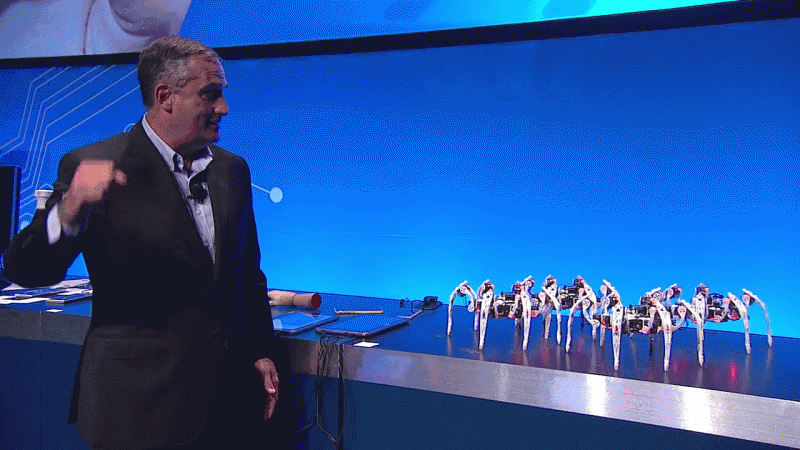April 10, 2015 weblog
At IDF: Wake up, spiderbot, the wristband said

There they stood, silent, motionless, a quartet of machine spiders, waiting for their cues, like a dancer troupe waiting for curtains to rise on opening night. At Intel Developer Forum in Shenzhen, China, earlier this week, their "director" was not to disappoint the audience and the show was on. Intel CEO did the directing, putting on a wristband and, with a bunch of air gestures, had the spiders moving at his command.
CEO Intel Brian Krzanich's spiderbot show reflected continued developments in Curie. The IDF audience saw what can happen when putting on a wristband that has an embedded Intel Curie module, connecting with the spiderbots and triggering how they could talk to each other. Krzanich's wristband motions controlled the robots' movements.
He woke up the robots with one motion; they rose and stood on their legs. Another gesture had them lifting a limb, and another gesture put them to sleep again. Krzanich also used a special motion to change the LED colors on the robots.
The entertainment value was in watching someone wave hands in the air to make little robots do things but the technology story rests with Curie, a tiny computer introduced at CES earlier on, with its special hardware and software built in. Curie was the item on the wristband that can understand motion—not only movements left and right but also capable of interpreting the mode of motion—running, swimming, walking.
Packed into the computer are components that empower Curie as a working system. The Intel Curie module is a tiny hardware product based on the Intel Quark SE system chip, which is the company's purpose-built system on a chip for wearables, according to Intel. "It contains Bluetooth low-energy radio, sensors and battery-charging technologies." A coin-sized battery enables it to run for extended periods. Dan Moren in Popular Science noted an accelerometer and gyroscope detect arm gestures. The device can transmit commands to the robots via the Bluetooth LE module.
Intel has invested its focus on Curie with companies that are interested in developing wearable tech in mind. Curie was developed to be embedded as the key that makes wearable form factors intelligent—from rings to bags to pendants, bracelets and buttons.
Intel's Mike Bell has been quoted as saying, "In the future, we will see wearable products created by companies that have historically never used silicon before…It's now up to the ecosystem to innovate with this technology; rings, bags, bracelets, pendants and yes, buttons, will all be possible."
© 2015 Tech Xplore




















